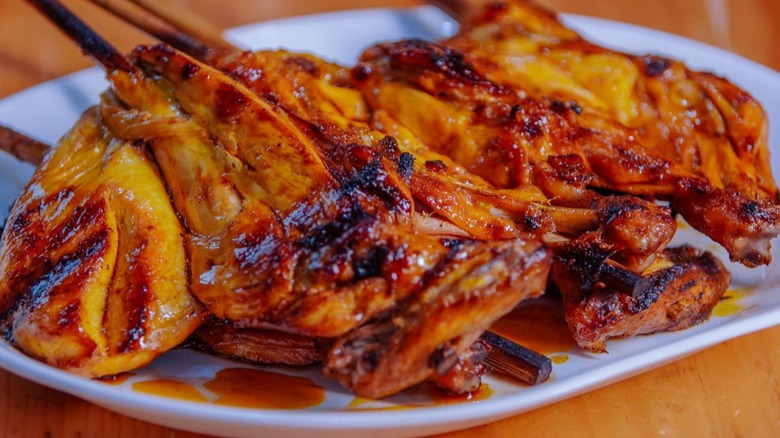Chicken Inasal: The Robust Filipino Street Food You Should Know
A number of the most memorable dishes to come out of the Philippines were born as street cuisine, and chicken inasal is one of them. Inasal — which means "skewered" in the central Philippine Hiligaynon dialect — is a piece of chicken that has been marinated and skewered before it is barbecued over a charcoal grill, per Sigrid Says. And while that may not sound like much, the chicken takes on the flavor of a complex marinade that brings together a knockout combination of spices and liquid condiments which vary from one restaurant to another, so no two servings of chicken inasal taste exactly the same.
Adobo Network says chicken inasal stands out from other grilled chicken dishes commonly found around the Philippines because it doesn't use a soy sauce-based marinade. Instead, the chicken is a canvas for a medley of flavors including garlic, ginger, coconut vinegar, lime, and more, per Panlasang Pinoy. This simple, yet flavorful street food is well-known and beloved across the Philippines, but when and where did the love for this dish begin?
History of chicken inasal
Chicken inasal started out as the 1970s equivalent of fast food in the city of Bacolod, which is in the western region of the Philippines (via YouTube). It was a quick and easy meal that could be eaten on the go by commuters and public transport drivers who converged on the city's commercial hub, the Bacolod City Public Plaza, per Adobo Network. Because many of the restaurants that served inasal were clustered on a nearby street, DG Traveler says the strip was soon renamed "Chicken Alley."
Bacolod wasn't the only place where people in search of chicken inasal might find it. In her 1988 book "Sarap," renowned Filipino food writer Doreen Fernandez references inasal, saying: "Chicken in [the Philippine city of] Silay is always associated in my memory with inasal, the local barbecue, which used to be available at merienda time only in the market area. The chicken parts are marinated in tuba [fermented coconut vinegar, per Serious Eats] and garlic, then brushed with lard while grilling over coals..." per Facebook.
Fernandez added that inasal, once a food for the masses, became "institutionalized" after Manokan Country – a food center where all of the stalls specialize in chicken inasal — opened up in Bacolod. Fast forward to now and Manokan Country is still one of the most sought-after places to enjoy this dish, but it can also be found in restaurants across the Philippines.
How chicken inasal is prepared
While chicken inasal goes by just one name, there are many different versions of the dish. As DG Traveler points out, all marinades start with calamansi or Philippine lime, pepper, coconut vinegar, as well as annatto, an extract from the achiote tree, but the similarities end there. Aside from the aforementioned base ingredients, Panlasang Pinoy's version of this grilled chicken dish boasts ginger, lemongrass, and lemon soda. After the chicken is marinated for 1 to 3 hours, it is thrown on the grill and basted with a flavorful sauce that is made with annatto oil, margarine, salt, calamansi, or lemon juice.
A recipe from Serious Eats has a similar marinade, but also calls for the addition of dark muscovado sugar as well as Maggi seasoning for a burst of umami. For a basting sauce, the site recommends using coconut oil instead of margarine.
Marinades and basting sauces aren't the only ways this dish can differ, because the chicken can be grilled and served in different ways. Some restaurants might cook their chicken over searing hot charcoal until the skin is slightly charred but the meat is moist, while others might serve their chicken on the dry side, per Sigrid Says.
How chicken inasal is served
Chicken inasal restaurants don't just marinade and baste the dish in different ways, they offer different dipping sauces too. DG Traveler says a diner should expect no less than soy sauce (patis), vinegar (sinamak), chili peppers (katumbal), as well as more Philippine limes or calamansi. Some inasal restaurants offer chicken oil as a dipping sauce, which is fat rendered from the chicken and chicken skin mixed with annatto oil, per Food52.
Diners can also choose what type of meat they prefer on the skewer. According to DG Traveler, it is customary to enjoy chicken offal like the gizzards and intestines as an appetizer, then diners can choose between chicken breast (pecho), leg (paa), or wing (pakpak) for their entree.
The skewers are then served with rice — because no Filipino meal is complete without it (per National Nutrition Council) — and options include plain steamed or garlic rice with a generous pour of annatto or chicken oil over the top. If you find yourself in front of a tempting plate of chicken inasal, you might want to do as the locals do: Ditch the utensils and devour the dish with your hands, per DG Traveler.



